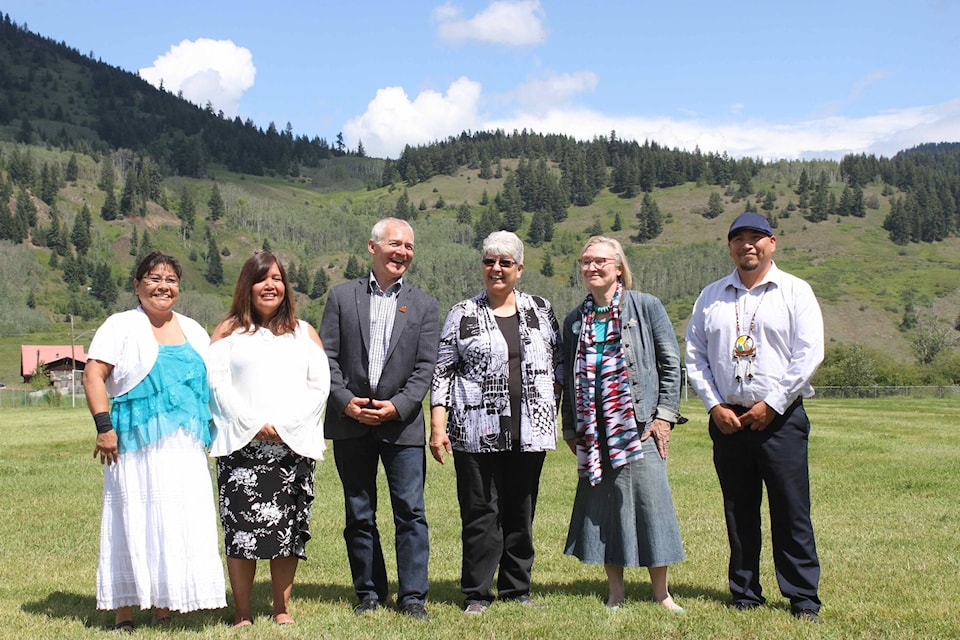Sunday morning’s signing of the agreement-in-principle between the Northern Secwepemc te Qelmucw people and the government of B.C. was 25 years in the making.
Chiefs from the four bands of the NstQ - Canim Lake’s Tsq’escen’ First Nation, Canoe Creek and Dog Creek’s Stswecem’c-Xgat’tem First Nation, Williams Lake’s T’exelc First Nation and Soda Creek’s Xat’sūll First Nation - along with Carolyn Bennett, federal Minister of Crown-Indigenous Relations and Scott Fraser, British Columbia’s Minister of Indigenous Relations and Reconciliation, participated in a signing ceremony at the Eliza Archie Memorial School in Canim Lake on Sunday, July 22.
Chief Helen Henderson, of Canim Lake, called the event “a pitstop,” a chance to mark 25 years of hard work before heading into final agreement negotiations.
“It’s a mark to acknowledge all the hard work of all of our treaty staff, our community members, our former leadership, especially our former Chiefs that got us into this process and lead us through 25 years plus,” she said.
Henderson has been a part of the process for years, but has only recently stepped into leadership and said she can’t take all the credit for this milestone.
The next step, she said, will take hard negotiations.
“We’re going back to those outstanding issues and trying to come to some kind of resolution.”
Henderson said a major goal for her people is to increase and secure land base from their traditional territory.
She said her people’s land is vast and that they see land bought and used by the crown every day.
“Our people need places to live, our people need places to hunt, fish, gather and more,” she said. “As this process goes along we see more of our lands being bought up and sold. The faster we get to this point, the more land base we’re able to secure for our people.”
The ceremony began with prayer from Ella Gilbert, a Canim Lake elder. Former Chief Michael Archie danced in the flags carried by two RCMP officers and then children came out in regalia to dance along to traditional drumming.
Bennett thanked the children for their performances and said, “when children grow up proud of who they are with that secure personal cultural identity, we know that that means much better health, education and economic outcomes.”
She said it’s a good sign to see children in regalia, showing pride for their culture.
Bennett said today’s signing launches them towards a final treaty “that ensures that you have the lands, resources and authorities that support self-government, self-determination and a strong ongoing government-to-government relationship.”
She said the only way to move forward and eradicate the racism our country still faces is for all Canadians to understand and acknowledge Indigenous rights.
Fraser mirrored Bennett’s sentiments, saying he was proud to have been a part of a “once in a generation event” and to be active in the “constructive damage of the status quo.”
He aspires for the future treaty to be a “living document” allowing for circumstancial adjustments and was met with cheers when he said, “extinguishment and surrender of rights has no place in modern day treaties.”
He said reaching a final treaty will take hard work but that the optimism among all sides involved was palpable.
Chief Ann Louie, from Williams Lake, called the day “powerful” and said it’s been a long 25 years in the making.
Louie expressed two areas in the current agreements that need work - child welfare and land.
She said they will be negotiating to “protect and govern our own children, our own families and take care of our elders.”
She addressed Bennett and Fraser directly when she said she expects both the federal and provincial governments to “step up” in providing much more land.
“We’ve always said that those lands are not sufficient,” she said, adding: “We expect much more than postage stamps.”
Chief Andrea Gilbert, of Soda Creek, said she looks forward to the future where children and grandchildren will have “a better self-determination” and where the world will acknowledge her people as strong and beautiful.
Chief Patrick Harry, of Canoe and Dog Creek, called the reconciliation process “a journey, not a destination.”
Harry, who has been involved in treaty negotiations for 10 years, said he plans for his two young children “to rely on their rights and their title forever.”
He said that’s something he would never sign away.
Harry took the time to bring up former Chiefs who attended the event to thank them for their role in negotiations.
The signing ceremony concluded with a gift exchange.
Youth from the four First Nations communities presented Bennett and Fraser with art from a Canoe Creek artist.
Fraser presented the four Chiefs with reproductions of archived documents - pioneer medal applications from 1970 that were awarded to people born or living before 1897.
Bennett gifted the Chiefs with a hardcover book with art collected in Canada for the past 50 years.
